Wincher Review: Is This Rank Tracker Worth Your Investment?
In this hands-on Wincher review, we test the platform’s core capabilities, evaluate pricing and integrations, and walk through practical ways to use keyword data to drive content decisions. Read on for clear takeaways about cost vs. value, which target audience benefits most, and a simple 14-day test plan you can run yourself.
What is Wincher?
Wincher is a focused rank tracker originally built in Sweden to simplify how website owners monitor keyword performance. Launched by a small team, the platform concentrates on delivering accurate, easy-to-read ranking data rather than trying to be an all-in-one SEO suite. That laser focus makes Wincher a strong option for bloggers, small businesses, and in-house marketers who need reliable keyword tracking without unnecessary complexity.
Rather than spreading resources across dozens of features, Wincher centers on core capabilities: tracking keywords, surfacing search volume and position changes, and letting you compare performance over time. This practical approach appeals to users who want clear, actionable insights about how their website and specific pages are ranking in search — and how those rankings change after content updates.
Who uses Wincher? Typical users include solo bloggers monitoring long-tail keywords, small businesses tracking brand and local search terms, and content teams that want a straightforward way to measure SEO impact. For example, a niche blog can use Wincher to identify underperforming pages by keyword, then prioritize content edits to improve organic search traffic.
Ready to track your rankings?
Start monitoring your keyword positions with Wincher’s 14-day free trial. No credit card required.
Key Features of Wincher
Wincher focuses on a compact set of features that support practical rank tracking and keyword-driven content decisions. Below we break down the core capabilities — keyword tracking, competitor analysis, keyword research, and reporting — and show how each feature helps you generate better SEO results.
Keyword Tracking
![]()
At its core, Wincher is a rank tracking tool built around continuous keyword monitoring. The platform lets you track specific keywords and see their ranking position history so you can spot trends and measure the impact of content changes. Typical metrics shown for each keyword include current rank, position changes over time, search volume, CPC, and estimated monthly traffic — all data points you can use to prioritize content work.
How to use keyword tracking to prioritize content (example):
- List your target keywords and note current ranking position.
- Filter for keywords with decent search volume but rankings on page two (positions 11–20).
- Estimate potential traffic gain using CPC and search volume to prioritize pages to update.
- Implement on-page improvements for the highest-potential keyword and monitor position changes daily.
Practical tip: during your free trial, add 10–20 high-priority keywords and check daily position deltas to quickly see which pages respond to content edits.
Note: verify in your account which search engines and regions Wincher supports — the platform emphasizes Google rankings, and region settings affect the relevance of search volume and local results.
Each keyword entry displays crucial metrics including:
- Current ranking position
- Position changes (daily, weekly, monthly)
- Search volume
- Cost Per Click (CPC) data
- Estimated monthly traffic
Competitor Analysis
Wincher’s competitor analysis feature lets you compare your ranking positions to those of competitors for the same keywords. You can add competitor domains and view a color-coded summary that highlights where you’re winning or lagging — a fast way to spot gaps and opportunities for content improvement.
Example workflow:
- Add three main competitors to a keyword group.
- Sort by keywords where competitors outrank you but have lower estimated traffic — these are potential quick wins.
- Click any ranking position to inspect the competitor’s page; analyze title tags, headings, and content depth to identify what to improve on your page.
Practical benefit: competitor tracking surfaces keyword opportunities you might have missed and helps you reverse-engineer content elements that correlate with higher rankings and more organic search traffic.
Keyword Research
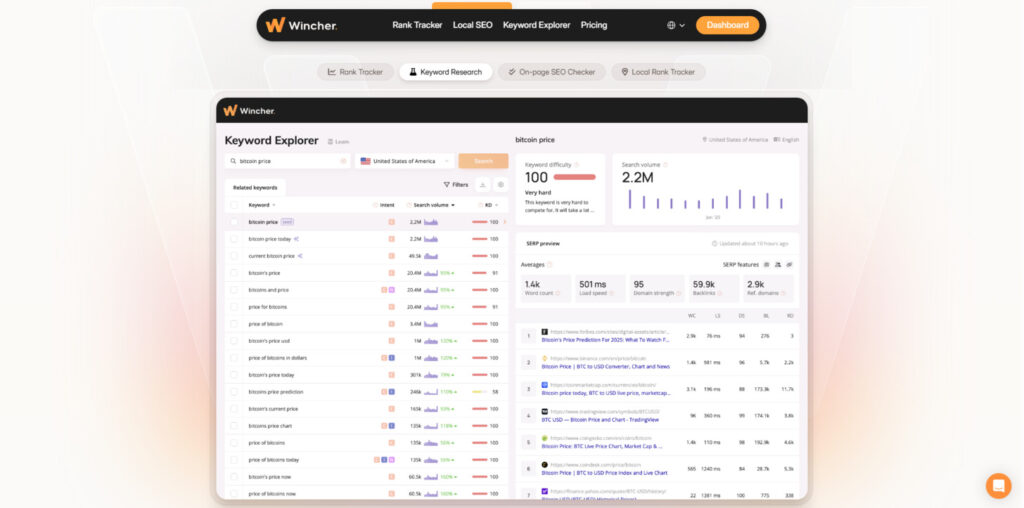
Wincher includes a keyword research capability aimed at discovering related keywords and low-hanging fruit based on your existing rankings. While it isn’t as comprehensive as standalone keyword research tools, it surfaces relevant keyword suggestions and provides essential metrics to evaluate them.
For each suggested keyword, Wincher shows:
- Monthly search volume
- Competition level
- User intent indicators
- Current ranking position (if applicable)
How to use these insights (example): combine search volume, estimated traffic, and the current ranking to calculate an expected traffic uplift if you move a keyword from position 12 to position 5. Prioritize keywords with moderate-to-high volume and lower competition for fastest results.
Micro-CTA: add promising suggested keywords to your tracking list with a single click during the trial to see how they trend over time.
Reporting and Notifications
Wincher’s reporting system lets you generate scheduled reports and set up notifications so you stay informed without logging in every day. Reports can be customized by frequency (daily, weekly, monthly), keyword groups, and data format, and you can add multiple recipient emails for team sharing.
Notifications highlight notable changes — for example, sudden drops or significant gains in rankings — and can be used to trigger immediate investigation or content action.
Example report scenario: schedule a weekly report for your top 50 keywords to see progress and share a concise results snapshot with stakeholders. Combine that with Slack or email alerts for critical ranking drops so you can react quickly.
Monitor your SEO progress effortlessly
Set up automated reports and get notified of important ranking changes with Wincher.
WordPress Integration
One of Wincher’s most practical features is its WordPress plugin, which brings keyword tracking directly into your content management workflow. Instead of switching between a separate rank tracking dashboard and your site, you can view key keyword metrics and ranking changes from inside WordPress — a real time-saver for bloggers and content teams who publish frequently.
What the plugin shows (typical):
- Keywords you’re tracking and their current ranking positions
- Competitor comparison data for those keywords
- Recent ranking changes for each tracked keyword
- Keyword tables with search volume, estimated traffic, and CPC where available
Quick installation and setup (step-by-step):
- Install the Wincher plugin from the WordPress plugin directory and activate it.
- Connect the plugin to your Wincher account (you’ll likely need to log in — confirm whether an API key is required in your account settings).
- Choose which website profile (if you manage multiple sites in Wincher) to link to this WordPress install.
- Import or add 5–10 keywords to test the integration and display data in the dashboard widget.
How to use it in a typical content workflow:
- Publish a new article or update an existing page.
- Open the Wincher dashboard panel in the WordPress editor or dashboard to check tracked keywords for that page.
- Spot a keyword with a small position gain or loss; update the page title, meta description, or headings and re-optimize content.
- Monitor the particular keyword over the next few days to see if the changes move the ranking — small improvements can compound into meaningful organic search traffic gains over time.
Interpreting the keyword table (example): if a tracked keyword shows search volume of 1,200/month, a current position of 14 and a moderate CPC, that’s a good candidate for optimization: moving it into the top 10 can materially increase organic search traffic for that page. The plugin feature allows you to see these signals without leaving the CMS, so you can act quickly when opportunity appears.
Practical tip: during your free trial, install the plugin and test it with 5 high-priority keywords and one competitor to validate data freshness and how quickly rankings react to content edits.
Wincher Pricing Plans
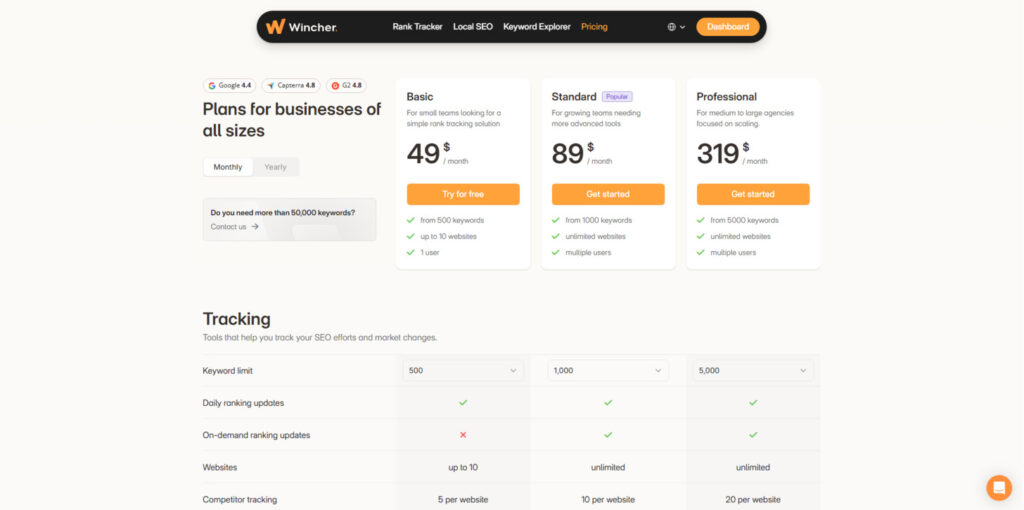
| Plan | Price | Keywords | Websites | Check Frequency | Key Features |
| Basic | $49/month | 500 | 2 | Daily | Local rank tracking, Basic competitor tracking |
| Business | $89/month | 1,000 | Unlimited | Daily | Extended local tracking, Advanced competitor analysis, Share of voice metrics |
| Professional | $319/month | 5,000 | Unlimited | Daily | Priority support, Project permissions, Team management |
Wincher’s pricing is straightforward and positioned around how many keywords you need to track per month and the scale of your operation. At a glance, the main differentiator between plans is keyword allowance and team/collaboration features — everything else (daily checks, core reports) is consistent across tiers. The per month cost should be assessed against how many keywords you actually need to monitor and how much time you save with automated reports and alerts.
Quick decision guide — which plan fits you?
- Starter ($49/month): Best for a single website or blogger tracking up to 500 keywords across 2 sites. If you monitor brand terms and a handful of content pages, this plan gives daily rank tracking without breaking the bank.
- Business ($89/month): Suited for growing businesses and small agencies that need to track thousands of keywords and multiple client websites. The added competitor analysis and share-of-voice stats help justify the higher monthly investment.
- Enterprise ($319/month): Designed for large organizations or agencies with broad keyword portfolios and team management requirements — useful when you need project permissions, priority support, and bulk keyword capacity.
Two short examples (who picks what)
- Solo blogger: Jane runs a niche blog with ~50 target keywords and a handful of long-tail phrases. Starter is more than enough; she can monitor performance, run keyword research, and use reports to iterate on content every month.
- SEO agency: A small agency managing five clients with several thousand keywords will likely choose Business. The ability to track multiple websites and access share-of-voice metrics makes the $/month spend worthwhile.
Free trial and what to test
All plans include a 14-day free trial with no credit card required — a low-friction way to validate the platform. During your trial, use this checklist to get the most meaningful results:
- Track 8–10 high-priority keywords across your main website and one competitor.
- Set up one automated weekly report and add one recipient email (your editor or manager).
- Create alerts for sudden ranking drops (e.g., >5 positions) and test notification behavior.
- Use the keyword research suggestions to add 3–5 new keywords and watch how they trend.
- Measure the time you save on manual rank checks and whether the reports give actionable insights.
Practical note: confirm in your account the exact trial limits — historically the trial allowed tracking up to 10 keywords, but offerings can change; double-check during signup so you can plan your test effectively.
Find the right plan for your needs
Start with Wincher’s 14-day free trial and upgrade to the plan that fits your requirements.
User Interface and Ease of Use
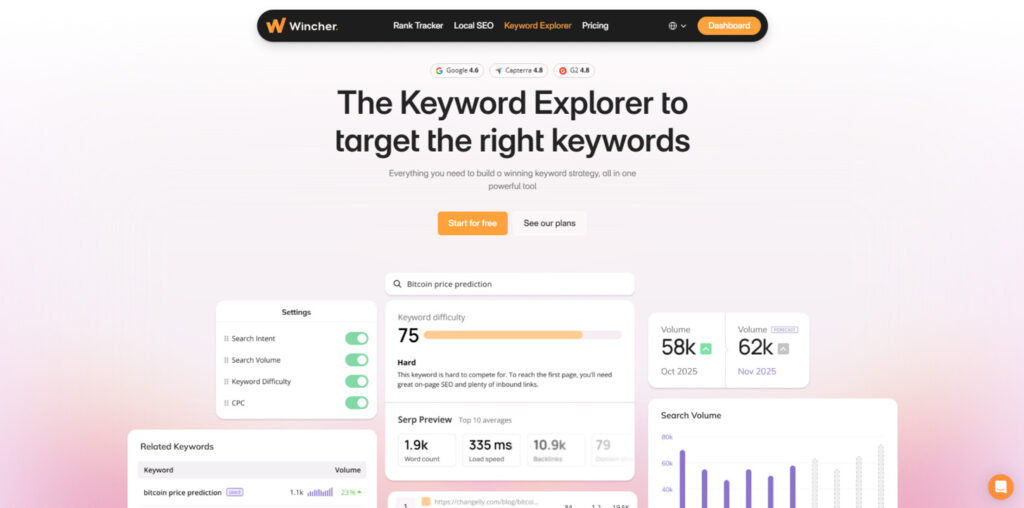
One of Wincher’s strongest selling points is its clean, intuitive dashboard. The interface is designed so that marketers with limited technical background can start tracking keywords and interpreting results quickly — making the tool a practical choice for small businesses, bloggers, and in-house content teams who want useful SEO insights without a steep learning curve.
The main dashboard surfaces the most important keyword metrics at a glance: current position, recent position changes, estimated traffic, and search volume for each tracked keyword. Navigation is straightforward, with a clear menu to access keyword groups, competitor comparisons, reports, and settings — which reduces the time you spend hunting for the data you need.
Quick onboarding — what you can do in the first 10–15 minutes:
- Add your website URL and confirm your target region (important for accurate local results).
- Import or add a list of keywords you want to track (20 keywords can be added and start collecting data immediately).
- Highlight high-priority keywords and add competitors for direct comparison.
- Run a keyword research pass to discover a few new targets to include in your list.
Within minutes you’ll have an overview of top-performing pages and the keywords that drive them, giving immediate, actionable context. For many users this “fast win” is where the value of Wincher becomes obvious: you can identify a page with several keywords ranking between positions 11–20 and prioritize those pages for optimization.
Data visualization is another area where Wincher helps you make faster decisions. The platform uses clear graphs, sparklines, and color-coded indicators (green for gains, red for drops) so position changes and trends are easy to interpret at a glance.
UX caveat: while the interface is generally straightforward, you may encounter occasional minor usability quirks — a filter that behaves unexpectedly or a report setting that needs manual tweaking. These are manageable, but worth noting if your team relies heavily on complex, automated workflows.
Example — before and after a content edit: imagine a page ranking at position 14 for a particular keyword with 1,200 monthly searches. After updating headings and adding a two-paragraph section targeting the user intent, Wincher shows a small upward trend within days and a jump into the top 10 in subsequent weeks — the dashboard’s position change highlight and traffic estimate together make it easy to quantify that improvement.
Integrations and Compatibility
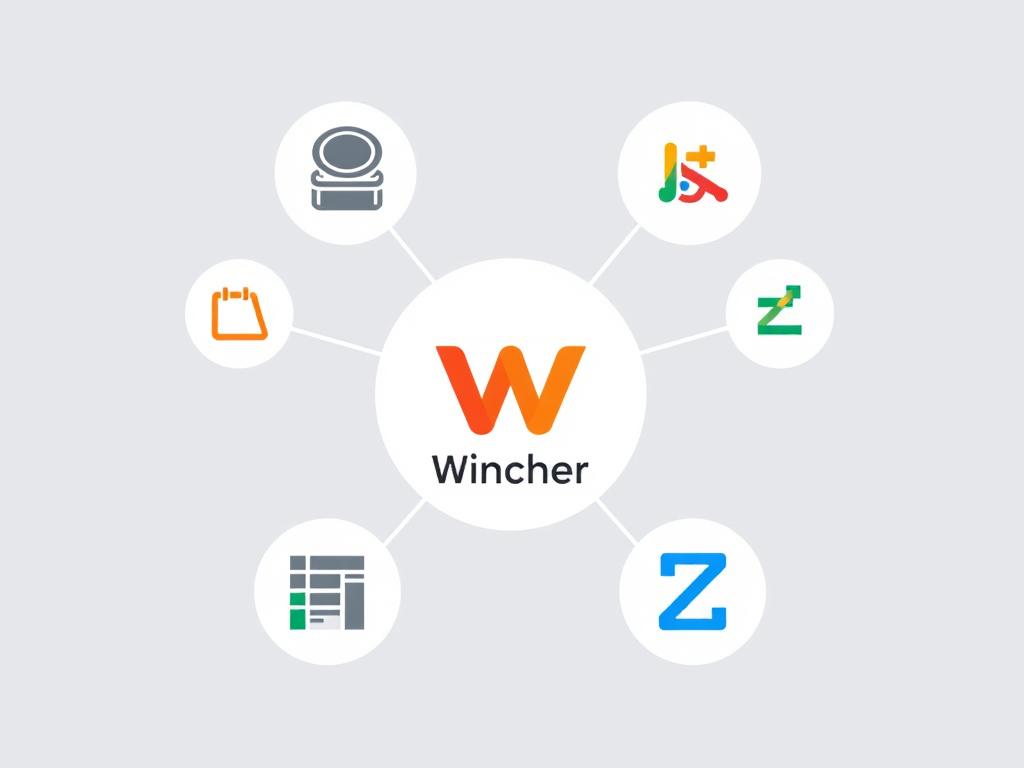
Although Wincher is primarily focused on rank tracking, the platform offers a handful of practical integrations that help it fit into existing SEO workflows and amplify the value of your keyword data.
WordPress Plugin
The WordPress plugin (covered earlier) is the most convenient integration for content creators: it surfaces keyword tracking data inside your CMS so you can act on insights while editing pages. The feature allows you to check keywords, see recent position changes, and compare competitor data without leaving WordPress — ideal for content teams and solo bloggers who publish and optimize frequently.
Google Analytics
Wincher connects with Google Analytics to let you view traffic signals alongside ranking data. This connection helps you correlate rank improvements or drops with organic traffic changes, so you can evaluate whether a ranking move translated into real results. Check whether your account uses GA4 or Universal Analytics and confirm compatibility in the integration settings before relying on combined reports.
Slack Integration
Slack integration brings notifications into your team channels. For example, you can set an alert for a drop of 5 positions or more on a high-priority keyword so the content team can investigate immediately. This is handy for teams that use Slack as their primary comms hub — it reduces the time between detecting a problem and taking corrective action.
Zapier
Wincher also supports Zapier, enabling you to connect keyword and ranking events to over 2,000 other apps. Typical Zaps include creating a ticket in your project management tool when a top keyword drops or adding new suggested keywords to a Google Sheet for editorial review. The Zapier connection expands what the tool can do without forcing Wincher to build dozens of direct integrations.
Integration notes and quick checklist:
- Confirm which search engines Wincher supports in your plan — the platform emphasizes Google rankings, so verify multi-engine support if you need it.
- Check GA compatibility (GA4 vs Universal) before linking to ensure your traffic data lines up with ranking dates.
- During your free trial, follow this quick integration checklist: connect Google Analytics → install WordPress plugin (if applicable) → add one Slack channel alert → create one Zapier workflow to capture ranking drops.
Overall, Wincher’s integration options are intentionally focused: they cover the most valuable connections for rank trackers rather than providing every possible integration. The approach keeps the tool lightweight while still enabling practical automation and cross-platform data flows.
Pros and Cons of Wincher
Pros
- User-friendly interface with intuitive navigation that lowers the learning curve for new users
- Accurate rank tracking with daily updates so you can monitor position changes and short-term trends
- Excellent WordPress integration that surfaces keyword data inside your CMS
- Competitive pricing that scales well as you add more keywords
- Helpful keyword research suggestions for finding low-hanging fruit
- Customizable reporting and actionable notifications for team sharing
- No credit card required for the 14-day free trial
- Clean data visualization that makes position changes and trends easy to interpret
Cons
- Primarily focused on Google rankings, so users who need multi-engine tracking may find it limiting
- Geo-location support is basic (country-level), which can be a drawback for city-level local SEO work
- Keyword research features are useful but not as deep as dedicated keyword research tools
- Integration options are intentionally limited compared to large all-in-one SEO suites
- Occasional minor UX quirks that may require manual adjustments for complex workflows
Decision matrix — who should choose Wincher, and who should consider alternatives:
- If you want a focused, inexpensive rank tracker: Wincher is a great fit for bloggers, solo SEOs, and small businesses that need reliable keyword tracking and simple reports without an overwhelming feature set. Its target audience includes content creators and small teams who prioritize clarity and ease of use.
- If you need advanced research or multi-engine tracking: Consider larger SEO platforms that include comprehensive keyword research, backlink analysis, and multi-search-engine rank trackers. Agencies or enterprises that require city-level local tracking or deep competitor research may prefer an all-in-one tool.
Short examples that illustrate the pros and cons:
- Pro example: A small business tracks 200 keywords and uses Wincher’s reports to spot a page that jumped from position 12 to 7; estimated traffic projections show an uptick in organic visits, validating the team’s content changes.
- Con example: A local agency needs to track rankings in multiple cities for dozens of locations; Wincher’s country-level geo-targeting makes it hard to get precise city-by-city performance, so the agency opts for a geo-focused rank tracker instead.
Bottom line: Wincher is a practical, well-priced rank tracking tool for its target audience — bloggers, small businesses, and in-house content teams who want accurate rankings, clear keyword signals, and minimal fuss. If your workflow requires broader SEO features, multi-engine coverage, or advanced local targeting, evaluate alternatives as outlined in the alternatives section.
See Wincher in action
Experience the benefits firsthand with a 14-day free trial — test your top keywords, set notifications, and review automated reports to judge fit.
Wincher Alternatives

SE Ranking
SE Ranking is an all-in-one SEO platform that includes rank tracking across multiple search engines, backlink monitoring, website audits, and deeper competitor research. If your priority is a broader SEO toolkit (site health, backlink data, and rank trackers in one place), SE Ranking is a sensible step up from a pure rank tracker.
Example: a small to medium business that needs regular website audits and backlink insights in addition to tracking keywords across regions would pick SE Ranking to consolidate reporting and save time on research.
Mangools
Mangools (including SERPWatcher for rank tracking) is well-known for a beginner-friendly interface and concise toolset that balances keyword research and rank monitoring. It’s ideal if you want straightforward keyword research and a simple path to track movements without the complexity of larger platforms.
Example: a solo content creator who wants intuitive keyword research, clear SERP data, and an accessible rank tracker to move pages onto the first page will find Mangools easy to learn and use.
Semrush
Semrush is a premium, enterprise-grade digital marketing suite that includes rank tracking as part of a massive feature set: keyword research, content marketing tools, PPC data, competitive intelligence, and more. It’s the go-to if you need deep research capabilities and enterprise reporting — but it comes with a significantly higher price tag.
Example: an agency managing dozens of clients and aiming to push many pages to the first page google across varied keywords will use Semrush for its comprehensive research and scaling features.
- If you need a clean, budget-friendly rank tracker: Wincher is likely the best fit — simple UI and core rank tracking features to monitor keywords and pages.
- If you need backlink monitoring and site audits: SE Ranking gives you more research and audit tools alongside rank tracking.
- If you want beginner-friendly keyword research plus rank tracking: Mangools is easy to use and great for moving individual pages to the first page.
- If you need enterprise-scale research and multi-client reporting: Semrush is the most comprehensive option for agencies aiming at large-scale ranking improvements and first-page google outcomes.
Practical tip: use Wincher’s 14-day free trial to benchmark actual rank tracking accuracy and reporting speed, then run side-by-side tests with a competitor’s trial (for example, SE Ranking or Mangools) to see which tool’s keyword data and reporting better match your editorial workflows and help you reach your first page goals faster.
Customer Support and Resources
Wincher offers multiple support channels and a solid library of self-serve resources so you can get help and the information you need to make data-driven decisions. Whether you need quick troubleshooting or guidance on configuring reports, there are a few reliable ways to contact the team and find answers.
Email Support
You can submit support tickets via the Wincher website. Responses are typically provided within a business day, making email a good channel for non-urgent issues like billing questions or detailed account requests.
Help Center
Wincher maintains a help center with step-by-step guides, FAQs, and tutorials that cover setup, keyword tracking, reporting, and integrations. This is the fastest place to find documented information and practical walk-throughs for common tasks.
Live Chat
Live chat is available from inside the Wincher interface for faster, real-time help. Use it during your trial to validate data or to ask for assistance setting up a test — for example, get help adding 10 keywords and configuring a report so you can evaluate results quickly.
Social Media
Wincher is active on social channels where you can ask general questions or follow product announcements; however, for account-specific issues, email or live chat is typically faster and more secure.
How to reach support fastest:
- For urgent setup or data questions, start a live chat from within your Wincher account.
- For documented procedures, search the Help Center first — it often has complete step-by-step solutions.
- Use email for billing or complex tickets that require screenshots and longer back-and-forth.
Top 5 support questions new users ask (FAQ highlights):
- How do I connect Wincher to my website and set the correct region?
- Does the WordPress plugin require an API key or a login, and how do I install it?
- What are the trial limits for keywords and features during the free trial?
- How is search volume and estimated traffic calculated in reports?
- How do I set up Slack alerts or integrate with Google Analytics for traffic correlation?
Overall, Wincher’s support and documentation are designed to help you get useful keyword and traffic information fast, so you can focus on improving content and monitoring results.
Final Verdict: Is Wincher Worth It?
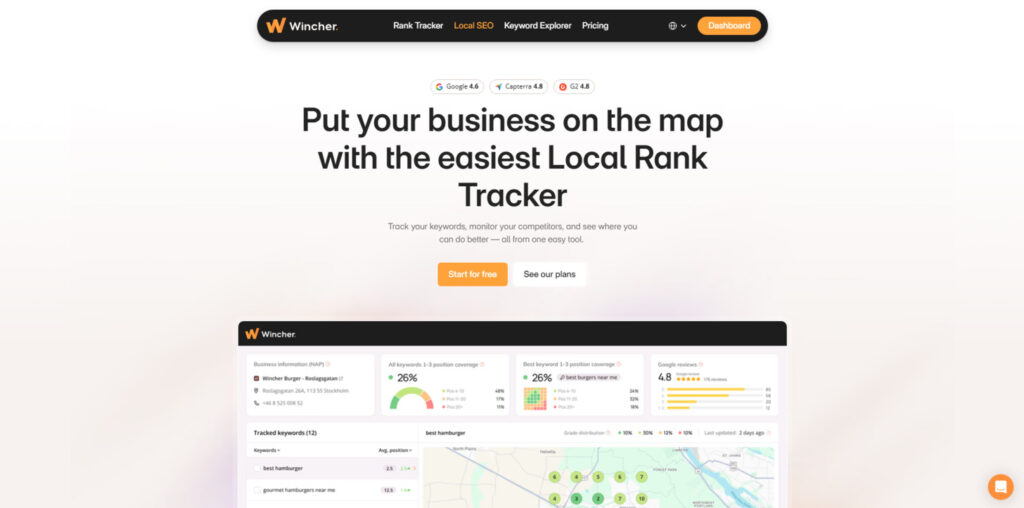
After a detailed Wincher review of features, pricing, and real-world usability, the verdict is clear: Wincher is a strong, focused rank tracking solution that delivers excellent value for a particular target audience. If your primary need is reliable rank tracking, straightforward keyword data, and fast, actionable reporting, Wincher gives you those capabilities without the complexity of larger SEO suites.
What Wincher does well: it provides accurate daily rank checks, clear ranking history for each keyword, and concise reporting that helps you correlate small on-page changes with measurable results. The WordPress integration and clean data visualization are practical extras that speed up editorial workflows — especially for content creators who want to push pages toward the first page of Google without wrestling with a bulky platform.
Where Wincher might not be the right fit: if you need multi-search-engine coverage, advanced local SEO with city-level targeting, or deep keyword research and backlink tools, you’ll likely want an all-in-one platform. For agencies or enterprise teams that require heavy-duty reporting, client management, and cross-engine tracking, upgrading to a broader toolset may make more sense.
How to test Wincher in 14 days (trial plan)
Use this simple trial roadmap to evaluate Wincher quickly and objectively:
- Day 1: Sign up and add 8–10 primary keywords that matter to your website. Confirm region settings so search intent and search results match your market.
- Day 3: Add 1–2 competitors for direct comparison and enable weekly reports. Note initial rankings and search volume for each keyword.
- Day 7: Perform small on-page tests on one or two pages (title tweak, add a paragraph targeting intent). Track position changes and estimated traffic shifts.
- Day 10: Set up notifications for drops greater than 5 positions and connect Slack or email if you use those channels.
- Day 14: Review automated reports and compare results: which keywords improved, which didn’t, and how actionable were the insights for your content plan?
This trial approach shows you not only the rank data but how quickly the platform surfaces opportunities to move pages toward the first page google — and whether Wincher’s data integrates well with your content process.
Quick alternatives and when to choose them
- Wincher: Best for bloggers, small businesses, and in-house content teams that need a simple rank tracker and clear keyword signals.
- SE Ranking: Choose it if you want built-in website audits and backlink monitoring plus rank tracking across regions.
- Mangools: Opt for this if you want beginner-friendly keyword research plus a lightweight rank tracker aimed at moving pages to the first page fast.
- Semrush: Select this if you need enterprise-level research, PPC data, and multi-client reporting to drive large-scale ranking improvements.
Final take: Wincher focuses on doing one thing exceptionally well — rank tracking — and that focus translates into a fast, easy-to-use tool that helps many users achieve tangible organic search results. For the right target audience (bloggers, small businesses, and focused content teams), it’s a cost-effective way to monitor keywords, test changes, and measure ranking improvements without unnecessary overhead.
Ready to improve your SEO performance?
Start tracking your keywords with Wincher’s 14-day free trial and see the difference for yourself. Or run a side-by-side comparison with another rank tracker during your trial to choose the best fit.




